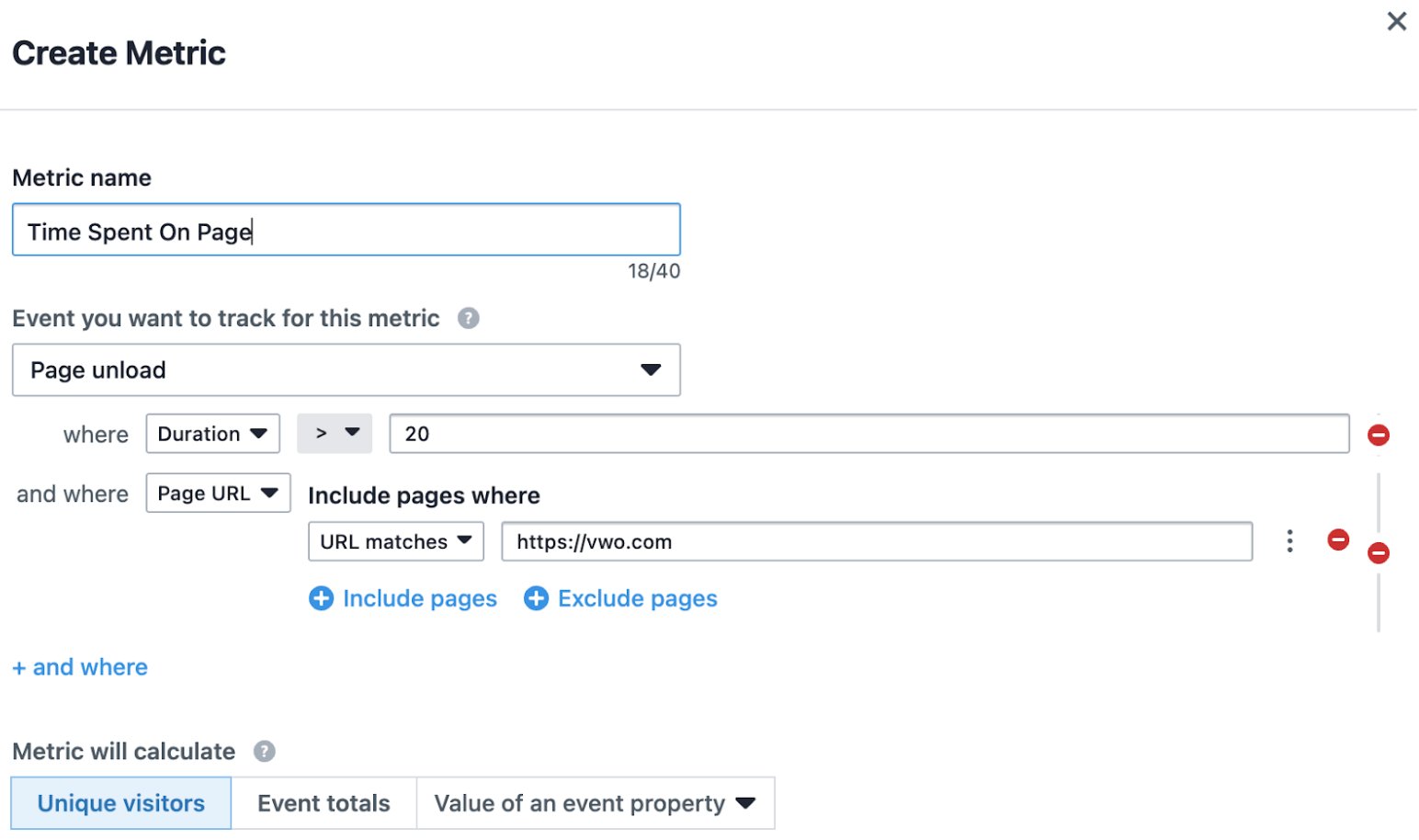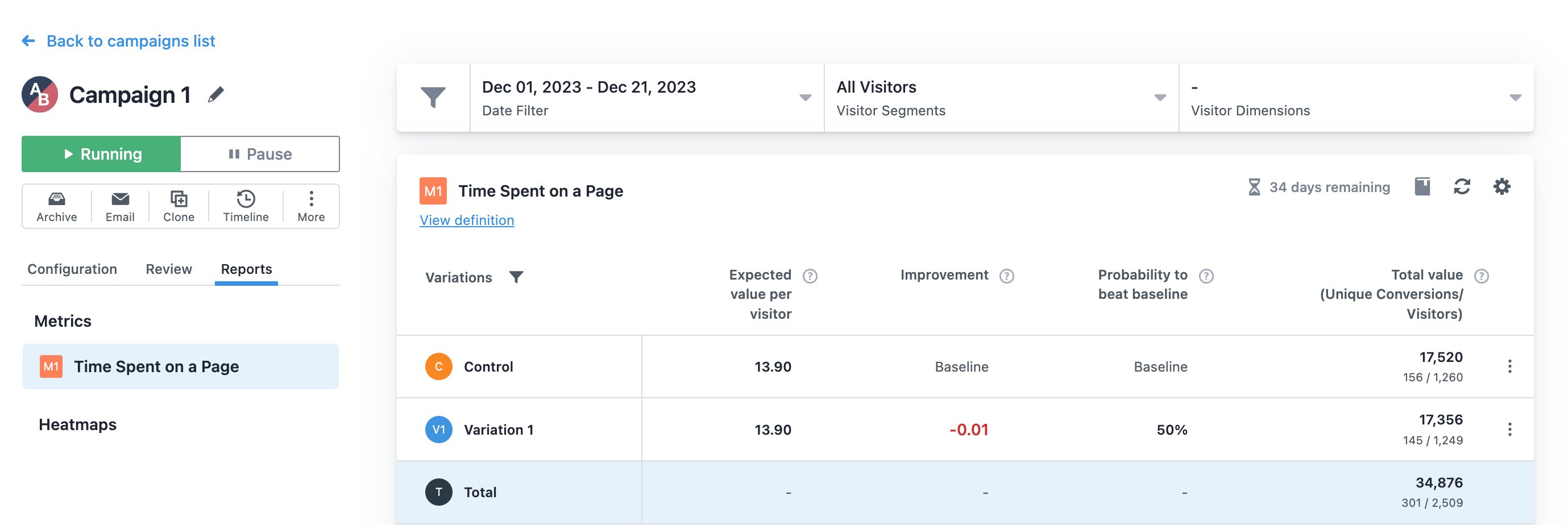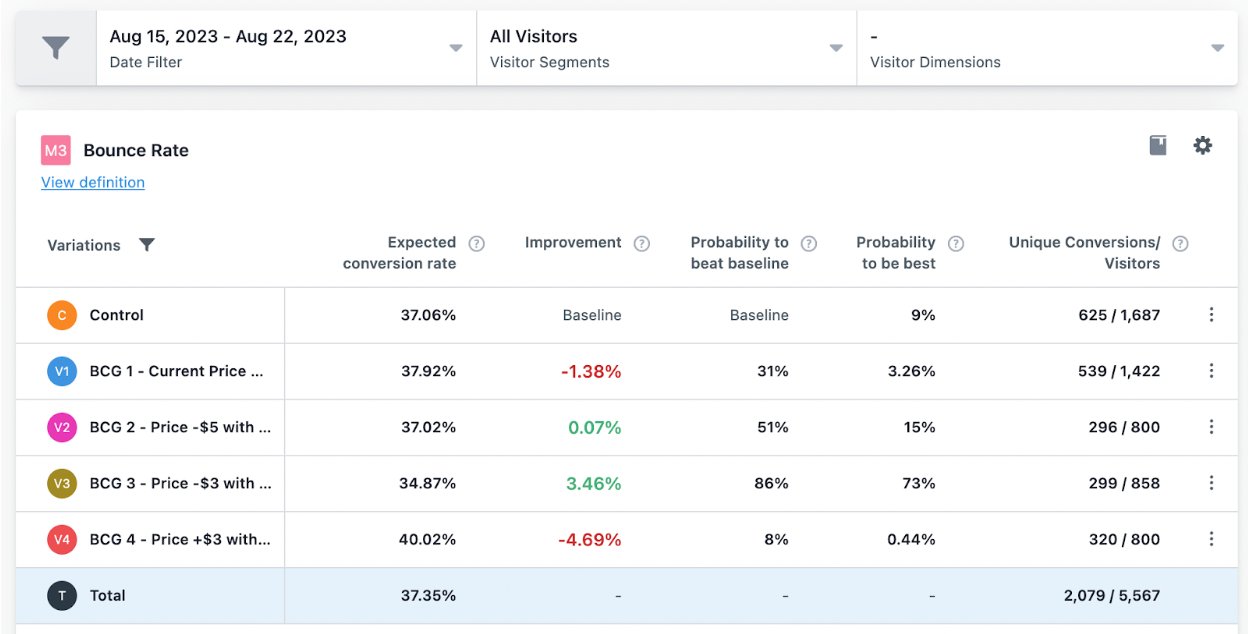Keeping visitors hooked to your pages is more difficult than ever in today’s fast-changing digital landscape. Low visitor attention spans compound the problem even further. No doubt, every second a visitor spends on your page counts, and that’s why it is crucial to understand how long users interact with your pages, what engages them, and why they might bounce away.
That’s exactly why we’re thrilled to announce adding two new powerful metrics – ‘Time spent on page’ and ‘Bounce rate.’
These metrics help you throw light on visitor behavior, empowering you to analytically optimize your website for higher engagement and, consequently, higher conversions.
Let’s take a deeper look at these metrics and how you can leverage them on your optimization campaigns in VWO to boost conversions.
1. Time Spent On Page Metric
What does it do?
The Time Spent On Page Metric measures how long visitors stay on your page. VWO’s ‘page unload’ event powers the calculation. VWO calculates the time spent on a particular page by computing the time difference between page load and page unload event.
VWO uses your campaign page URL by default while setting up the metric. You can also customize it by adding specific page URLs and setting a minimum duration (in seconds). This helps identify visitors who spent a specified minimum amount of time on chosen pages. Once set up, VWO counts only those visitors as conversions, streamlining your focus on engaged audiences.

Different use cases of how this metric can be used
Based on your specific use case, you can customize how these metrics count visitors:
1. Count only unique visitors who satiate the duration conditions by choosing ‘Unique Visitors.’ For example, you can use this configuration to track unique visitors who have at least spent 120 seconds browsing a course catalogue.
2. Calculate the count of the occurrences where a visitor has satisfied the duration stipulation by choosing ‘Event Totals.’ For example, you can see how many visitors stayed on your website for more than 30 seconds after offering a discount to those who have visited before.
3. Calculate the time spent by visitors across sessions by choosing ‘Value of an event property.’ This configuration helps calculate values such as cumulative time spent by the visitor during all the occurrences in which the visitor satisfies the duration stipulation (SUM), average time spent by the visitor during all the occurrences in which the visitor satisfies the duration stipulation (AVERAGE), and other values such as maximum duration, minimum duration, first value, and last value. For example, you can track the average time spent by visitors who satisfy the minimum duration on your blog pages to measure if the content is interesting.
How can you leverage the Time Spent On Page metric in VWO?
You can configure the metric according to the needs of your optimization campaigns to analytically determine which variations of your pages garner higher engagement and, therefore, resonate better with visitors.

For a step-by-step overview of how to use the Time Spent On Page metric, refer to our knowledge base article.
1. Optimize page content through A/B Testing
To fine-tune your page content, you can utilize “Time Spent On Page” as the primary metric in A/B tests. The duration visitors spend on a page reflects how well your content aligns with their interests. By running A/B tests with the ‘Time Spent On Page’ metric as the primary metric,’ you can empirically determine which types of messages and designs most appeal to your audience.
2. Enhance page engagement through personalization
Implement “Time Spent On Page” to gauge the effectiveness of personalized content in conversion campaigns. Evaluate various personalization strategies, like customizing content for different geographical locations or distinguishing between new and returning visitors, to identify the most effective approach for engaging your audience. This metric is crucial in pinpointing the most effective personalized messaging for engaging your visitors and eventually converting them into customers.
2. Bounce Rate Metric
What does it do?
VWO’s Bounce Rate metric tracks how many users bounced from your pages after becoming part of your optimization campaigns. VWO’s ‘Bounce’ event powers this calculation. VWO considers a visitor bounced if the visitor neither visits the same page nor proceeds to any other page after becoming part of your campaign.
You can utilize the Bounce Rate metric in your optimization campaigns to identify which versions of your design, content, and user experience effectively reduce instances of users leaving your page without engaging.
For more information on configuring the Bounce Rate metric, refer to our knowledge base article.
How can you leverage the Bounce Rate metric in VWO?
1. Use ‘Bounce Rate’ as a Guardrail Metric for A/B Testing
Incorporate the ‘Bounce Rate’ metric as a crucial guardrail during A/B testing. This metric is a protective barrier, ensuring that your essential business KPIs remain unaffected while conducting experiments. Specifically, it’s useful for monitoring bounce rates when modifying web content or design. By monitoring this metric, you can ensure your A/B tests don’t unintentionally raise bounce rates, thereby maintaining high user retention while enhancing your site.
2. Optimize pages with a high bounce rate
Leverage bounce rate as a pivotal metric in your A/B tests, particularly for pages exhibiting high bounce rates. When the bounce rate is part of an experiment as a metric, VWO considers lower bounce rate conversions as better performance. You can systematically reduce bounce rates by targeting such pages with high bounce rates, enhancing your site’s overall user experience and engagement.

3. Improving the relevance of content through personalization campaigns
You can utilize VWO’s bounce rate metric to gauge the effectiveness of personalization strategies in your campaigns. You can better tailor your content to suit visitor preferences by leveraging bounce rate metrics in personalization campaigns. This metric also helps reveal if personalization enhances visitor engagement or detracts from it, allowing you to optimize for better conversion rates.
Using Time Spent On Page and Bounce Rate metrics in the same campaigns
To analytically improve visitor engagement on your campaign pages and boost conversion, you can use Time Spent On Page and Bounce Rate metrics in your optimization campaigns. You can implement the time spent on the page as your primary metric to gauge user engagement while employing the bounce rate as a secondary metric to ensure the changes don’t adversely affect user retention. You can also save and reapply these metrics across various campaigns.
Maximize user engagement and maintain low bounce rates by utilizing VWO’s latest metrics to assess the effectiveness of your content variations. These metrics offer a complete overview of your campaign’s performance, enabling you to enhance your digital experience continuously.
Are you excited to try the metrics out?
‘Time Spent On Page’ and ‘Bounce Rate’ metrics are available on Growth, Pro, and Enterprise plans of VWO Data360 enabled VWO Testing – Web, and VWO Personalize accounts. We can’t wait to see how you’ll use these metrics to supercharge your optimization efforts. Log into your VWO account today and explore the power of these new metrics for yourself!
For any questions or concerns, feel free to reach out to support@vwo.com.









